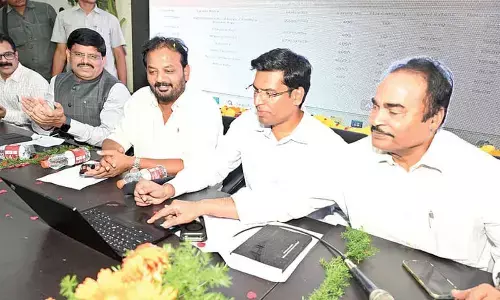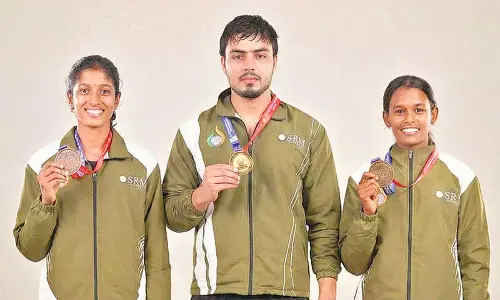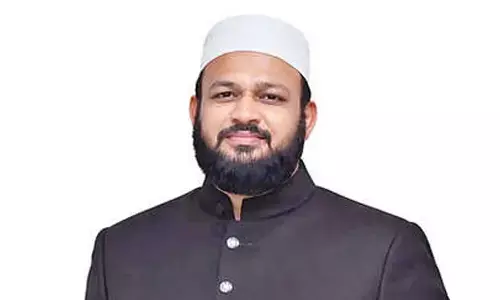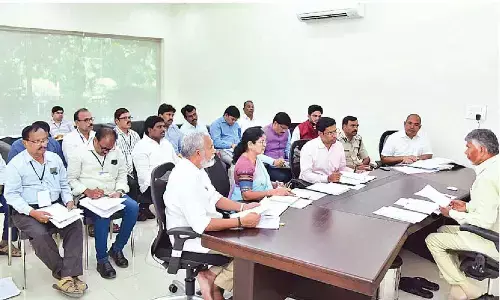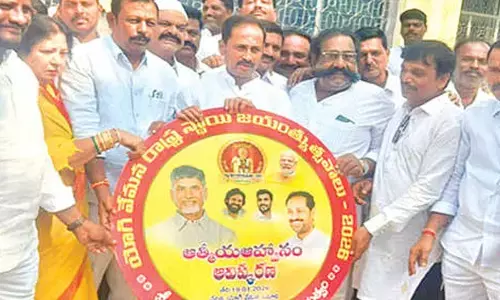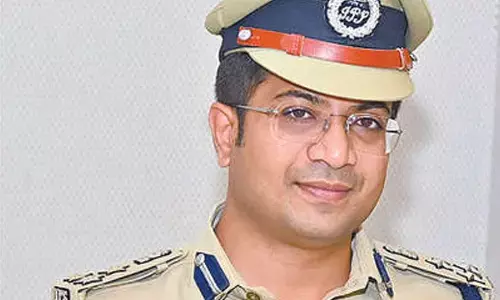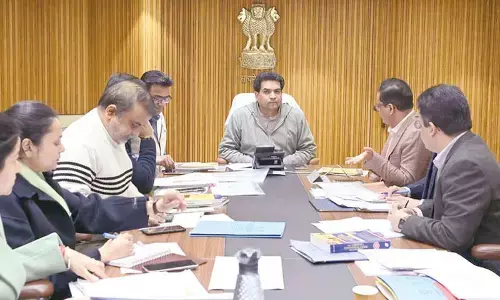A river of talent

When the heavens open up and rains are aplenty, the river Krishna short for Krishnaveni shows its mighty form flowing fast and furious taking with it all within its realm and beyond. Ironically, the fourth largest river in terms of water flow and river basin in the country, originating from Mahabaleshwar in Maharashtra has been described as just the opposite in Marathi...
When the heavens open up and rains are aplenty, the river Krishna short for Krishnaveni shows its mighty form flowing fast and furious taking with it all within its realm and beyond. Ironically, the fourth largest river in terms of water flow and river basin in the country, originating from Mahabaleshwar in Maharashtra has been described as just the opposite in Marathi...
“Shaanth Vahathe Krishnamaai” (quiet flows the Krishna). The sacred river that flows through Karnataka, Telangana and Andhra Pradesh, joining the sea at Hamsaladeevi, near Koduru in Andhra Pradesh has brought prosperity along its path. The river delta encloses the most fertile plains in the country and land owners here have harvested gold literally.
Vijayawada and Guntur, the cities with food grains and cash rich crops symbolise the benevolence of the mighty river, which has geological, biological, historical, political and cultural importance. Historically places around the Krishna were ruled by the ancient kingdoms of Satavahanas, Ikshvakus, Vishnukundins and the Kakatiyas.
The river’s journey from the Sahayadri hills is marked with devotional fervour as there are numerous temples on the way till it merges with the sea near the Venugopalaswamy temple at Hamsaladeevi. The temple of Goddess Kanakadurga atop the Indrakeeladri Hills, the Amaralingeshwara at Amaravati on the Southern bank of the Krishna, Srisailam Mallikarjuna Swamy, Sangameshwar and Alampur Jogulamba are some of the well-known temples in the Telugu states.
There are several other temples along the way each with the folklore and sthalapurana (importance of the place) specific to the deity in whose honour they were constructed. The Undavalli Caves on the banks of the Krishna towards Guntur are a fine example of rock cut architecture with a rare idol of the reclining Vishnu (Ananatapadmanabha Swamy) sculpted from a single block of granite.
They also reflect the Vihara style Jain architecture and Buddhist influences. With Amaravati being an important centre of Buddhism housing one of the most ancient and rare Kalachakra stupas known to ward off negative energies, the banks of the Krishna can boast of being home to different religions of the world.
There is a symbolism of heaven and all things perfect in the region that finds reflection in names like ‘Diviseema’ (abode of the divine) and ‘Amaravati’ (the place for immortals) and ‘Vijayawada’ (City of victory). Amaravati is now all set to emerge as the modern capital of the new state of Andhra Pradesh, bringing with it a slice of history, modernity and elegance of a city on a river front.
Repository of Literature
...And quiet flows, the Krishna bringing along a sweetness of rhyme and melody, a magic in the arrangement of words, a novelty of thought that gave rise to poetry, music, theatre, film and dance that have inspired connoisseurs of art and literature the world over.
Lenka Tummala Seetharamamurthi’s poem on the Krishna Pushkaram titled ‘Krishnaveni’ talks of the British trade from the Machilipatnam port, bringing prosperity to the region. He eulogises the Krishna ‘Neevu karunanidhivi kanuka nee thatammulu Aashrayammayye Bouddha vihaaramulaku’ (Since you are a treasure of compassion your banks were home to Buddhist Viharas that propagate peace and non-violence).
Viswanatha Satyanarayana, who belongs to Vijayawada, famed for his classical style of poetry and wide variety of works that include plays, novels, short stories and speeches, was a scholar honoured with the coveted Jnanpeeth and Padma Bhushan awards. His works like ‘Ramayana Kalpavrikshamu’, ‘Kinnerasani Kathalu’ and ‘Veyi Padagulu’ earned him the highest place of honour in Telugu literature.
Another literary giant from Guntur on the opposite bank of the Krishna is Jandhyala Papaiah Sastry popularly called ‘Karunasri’. His timeless works laced with compassion include ‘Pushpavilapam’ (agony of flowers) and ‘Kunthi Kumari’ along with ‘Karunasri’ born out of his visit to the Buddhist stupa in Amaravati. Gurram Jashuva, the poet who became the voice of the underdog, portrayed social injustice in his works, wrote about untouchability, dalit rights and segregation.
Gabbilam (the bat), Firdaus (a rebel) and Kandiseekudu (refugee) are some of his most famous works. Kshetrayya who wrote beautiful ‘padamas’ (verses) on his favourite deity Krishna becoming synonymous with ‘madhurabhakti’ (sweet devotion) belonged to Movva in the Krishna district and used the signature “Muvva Gopala” in his works.
Written in the Shringara style, his romantic love and yearning for Krishna are symbolic of the longing of the devotee (Jeevatma) to merge with the divine (paramatma). Kshetrayya’s works were popularised musically by Veena Dhanammal and T Brinda and came alive through beautiful dance compositions by the famous dance guru Dr Nataraja Ramakrishna.
Music, Dance and Theatre
Kuchipudi, a world famous classical dance form rooted in the ancient Natya Sastra is attributed to Siddhendra Yogi and derives its name from the Kuchipudi village in Krishna district. ‘Bhamakalapam’ the famous dance by Satyabhama, the beautiful and proud consort of Krishna has vowed audiences the world over beginning, with the time when male dancers dressed up as Satyabhama, to the present day, where women bring out her many nuances with feminine grace and strength that defined her character.
Eminent classical musicians like Susarla Dakshina Murthy and Parupalli Ramakrishnayya Pantulu, who are direct descendants of the sishya parampara of Tyagaraja were from Vijayawada with the latter being the guru of legendary multi-faceted Carnatic musician Dr Mangalampalli Balamuralikrishna.
Murali music defined by effortless singing, non-conformism, experimentation and boundless creativity blossomed in the Vijayawada city on the banks of river Krishna. Two great stalwarts of Telugu film music Ghantasala Venkateshwara Rao and S Janaki belonged to this river basin that seemed to nurture everything melodious going by the long list of musical greats of every genre.
Vijayawada and in particular Tenali, which came to be referred to as ‘Andhra Paris’ for the rich legacy of culture that it denoted were important places for the development of theatre bringing to the fore histrionics and singing capabilities of artistes who rendered poetry melodiously in mythological and social plays.
All night performances, impromptu poetry (Aasu kavithvam) and improvisation (changing characters, including new ones) marked the rich and varied canvas of theatre in Tenali, where the Andhra Nataka Parishad was formed in 1929.
A detailed history of the origin of theatre was penned by Nethi Parameswara Sarma in his book ‘Noorella Tenali Rangasthala charitra’ (100 years of theatre in Tenali). Vemuri Gaggaiah, DV Subba Rao, Madhavapeddi Venkataramiah and Kapilavai Ramanatha Sastry were some of the eminent theatre personalities, who lit up the stage in this culturally vibrant town.
Home Ground of Revolutions
From the renaissance to the revolutionary, from the culturally effervescent to the politically expedient, every important thought stream that enriched the life of Telugu speaking people has its roots in Vijayawada, the nerve centre of activity in the Krishna region. The construction of an Anicut on the Krishna in the second half of the 19th century resulted in a boom in agriculture, commerce and trade.
With the establishment of KCP industries in 1941 by Velagapudi Ramakrishna, a former ICS officer, industrialisation in the region received a fillip. The agricultural surpluses from the region found their way into cinema, transportation and agro-based industries.
New entrepreneurs also concentrated on education, with many private schools, colleges and coaching centres catering to parental aspirations centred on medicine and engineering making it an educational hub. After the establishment of the Andhra Loyola academy in Vijayawada in 1953, the establishment of the first private engineering college in the state in 1977 by the Siddhartha Academy remains most significant.
With affluence and education, progressive and reformist thoughts were a natural corollary and movements like communism, atheism and feminism found resonance in the region. Goparaju Ramachander Rao (Popular as Gora) was an Indian social reformer and freedom fighter, who started the Atheist Centre in Vijayawada along with his wife Saraswathi Gora and a few volunteers.
Born in an orthodox Brahmin family he shunned caste and organised “cosmopolitan dinners” every full moon night where people of all castes and religions participated. A Gandhian who believed in Sarvodaya (progress for all) he was even referred to as “Ghora (terrible in Telugu) by the press when he spearheaded an agitation to uproot ordinary plants in favour of vegetable yielding ones.
Vijayawada was the focal point of the area that covered Krishna, Guntur and Nellore districts of the Madras province, which saw the birth of the Communist movement in Andhra Pradesh in the 1930’s. The party engineered struggles against Challapalli, Munagala and Kalipatnam Zamindars during 1936-38 as also agitations by railway and press workers who formed trade unions.
Putchalapalli Sundarayya, C Basavapunniah, N Prasada Rao, Moturu Hanumantha Rao, L Balagangadhara Rao were some of the important Communist leaders from Vijayawada, who made a great contribution to the party.
During the Razaakar movement several families from Nalgonda and other districts of Telangana took refuge in Vijayawada, Bandar and neighbouring areas, which retain traces of the sacrifice and bloodshed of the Telangana armed struggle.
The political and cultural capital of Andhra heavily influenced by Communism in the 20th century logistically supported the armed struggle of the communists against the oppressive rule of the Nizam and many cadres were shot dead by the police here. It was also the nerve centre for the Jai Andhra agitation that followed a couple of years after the widespread Telangana agitation in 1969.
The agitation was so severe that no government writ ran for months. After a great deal of turmoil it came to a halt but Vijayawada continued to be under the grip of gangsters, who wanted to wrest control of the city. Murder and mayhem became the order of the day with communists groups pitted against other sponsored gangs.
These gang wars in course of time assumed caste dimensions with rival gangs eliminating one another. The rivalry between two families trying to gain control over the city resulting in deadly plots and murders became the subject of the hit film ‘Shiva’ that was a huge box office hit, encouraging director Ram Gopal Varma to seriously pursue the dark world of crime in film after film.
The caste riots in 1988 spearheaded by rival political parties after the death of Kapu leader Vangaveeti Mohana Ranga resulted in huge loss of property and life, looting and arson hitherto unheard of. Many places in Vijayawada were destroyed and later rebuilt from the ashes.
It caused a wave of resentment against Telugu Desam party and its supremo NT Rama Rao, who hails from Nimmakuru in Krishna district. The charismatic actor revered as God for his portrayal of mythological characters and founder of the Telugu Desam Party, a regional party that changed the discourse of politics in the Telugu land is a legendary figure whose campaign for “Telugu Pride” remains unparalleled in history.
Vijayawada retained its supremacy over the decades that followed as the political and cultural capital of the state through its many entrepreneurs, politicians and reformers. The gangster culture that dominated the area subsided due to declining political patronage and changing aspirations.
Vijayawada and Guntur continue to be relevant though and poised for a spurt in development as they become all important for progress in the new state of Andhra Pradesh. The National flag that flutters in the sky reflects the love and pride that one feels for the country and is an everlasting contribution made by Pingali Venkanna, who hails from Vijayawada.








